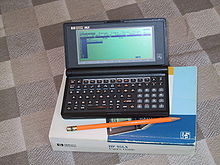HP 95LX
 Like most pocket computers, the HP 95LX owner's manual is larger and heavier than the computer itself. | |
| Also known as | Jaguar |
|---|---|
| Manufacturer | Hewlett-Packard[1] |
| Type | Palmtop PC |
| Release date | April 1991[2] |
| Introductory price | $550 |
| Discontinued | January 1, 2003 |
| Units shipped | 400,000 (estimated production run) |
| Operating system | Microsoft MS-DOS 3.22[3] |
| CPU | NEC V20 @ 5.37 MHz |
| Memory | 512 KB (F1000A) or 1 MB (F1010A)[4] |
| Removable storage | SRAM card (0.5 MB - 32 MB) |
| Display | 40 × 16 characters LCD screen (4.8 inch × 1.8 inch) |
| Graphics | 240 × 128 pixels (quarter-CGA resolution) monochrome STN, 2 scales |
| Sound | PC speaker (piezo) |
| Input | Thumb keyboard with 80 keys & dedicated numeric keypad[5][6][7] |
| Connectivity | RS-232-compatible serial port, infrared port, PCMCIA 1.0 type II (3.3 mm or 5 mm) |
| Power | 2× AA-size removable batteries, 1× CR2032 coin cell backup, optional AC adapter |
| Dimensions | Length 8.5 cm, width 15.9 cm, height 2.6 cm (3.4 inches × 6.3 inches × 1 inch)[5] |
| Mass | 312 g (11 ounces) |
| Backward compatibility | Intel 8088 |
| Successor | HP 100LX |
The HP 95LX Palmtop PC (F1000A, F1010A), also known as project Jaguar, was Hewlett Packard's first MS-DOS-based pocket computer or personal digital assistant, introduced in April 1991 in collaboration with Lotus Development Corporation. It can be seen as successor to a series of larger portable PCs like the HP 110 and HP 110 Plus.
The HP 95LX had an NEC V20 CPU (an Intel 8088 clone running at 5.37 MHz) with an Intel Corporation System on a chip (SoC) device. It cannot be considered completely PC-compatible because of its quarter-CGA (MDA) resolution LCD screen.[8] It ran Microsoft's MS-DOS version 3.22[3] and had a customized version of Lotus 1-2-3 Release 2.2 built in.[9][10] Other software in read-only memory (ROM) included a calculator, an appointment calendar, a telecommunications program, and a simple text editor. It also included a CR 2032 lithium coin cell for memory backup when the two AA main batteries run out. For mass storage, the HP 95LX had a single PCMCIA slot which could hold a static RAM card (which had its own CR 2025 back-up coin cell). An RS-232-compatible serial port was provided, as well as an infrared port for printing on compatible models of Hewlett Packard printers.[3] In character mode, the display showed 16 lines of 40 characters and had no backlight. While most IBM compatible PCs work with a hardware code page 437, the HP 95LX's text mode font was hard-wired to code page 850 instead.[3] Lotus 1-2-3 internally used the Lotus International Character Set (LICS), but characters were translated to code page 850 for display and printing purposes.[3]
Successor models to the HP 95LX include the HP 100LX, HP Palmtop FX, HP 200LX, HP 1000CX, and HP OmniGo 700LX.
See also
- DIP Pocket PC
- Atari Portfolio
- Poqet PC
- Poqet PC Prime
- Poqet PC Plus
- ZEOS Pocket PC
- Yukyung Viliv N5
- Sub-notebook
- Netbook
- Palmtop PC
- Ultra-mobile PC
References
- ^ Francis, Peter (December 1991). "HP 95LX. (palmtop computer) (Evaluation)]". COMPUTE! (136): 128.
- ^ "Hewlett-Packard 95LX computer". oldcomputers.net.
- ^ a b c d e HP 95LX User's Guide (PDF) (2 ed.). Corvallis, OR, USA: Hewlett-Packard Company, Corvallis Division. June 1991 [March 1991]. pp. E-1–E-3, F-1–F-7. F0001-90003. Archived from the original (PDF) on 2016-11-28. Retrieved 2016-11-27.
The HP 95LX character set is equivalent to code page 850, the IBM PC multilingual character set. (Note that your HP 95LX contains MS-DOS 3.22, which does not support code-page switching.) All the HP 95LX applications use this set except 1-2-3, which uses LICS, the Lotus International Character Set. Most LICS characters are included in code page 850; the few that are not will not display […] If your HP 95LX cannot display […] or if your printer cannot print a LICS character, the HP 95LX uses a fallback presentation for that character […] if you use the © symbol and your printer cannot print it, the HP 95LX might display (c) or c as the fallback presentation (depending on the capabilities of your printer).
{{cite book}}: Unknown parameter|dead-url=ignored (|url-status=suggested) (help) - ^ "95LX". HP Computer Museum.
- ^ a b Kendrick, James (2015-04-07). "HP 95LX: Remembering the early mobile DOS PC". ZDNet.
- ^ "HP95LX - How we test Palmtop computers". InfoWorld: 76. 1991-12-16.
- ^ "HP 95LX". Old Organizers Collection.
- ^ "DOS Palmtop: HP 95LX Details and specs". (List of DOS-based palmtop computers)
- ^ "HP 95LX". InfoWorld: 72. 1991-12-16. Retrieved 2016-11-26.
- ^ Matzkin, Jonathan (July 1991). "Hewlett-Packard Co. HP 95LX Palmtop PC". PC Magazine: 216, 220, 222. Retrieved 2016-11-26.
External links
- Hewlett Packard Web site on HP 95LX
- HP 95LX technical information (contains PCB photos) Archived 2006-09-26 at the Wayback Machine
- Skolob's Hewlett Packard 95LX Palmtop Page (Information and FAQ on 95LX)
